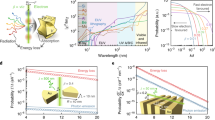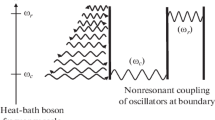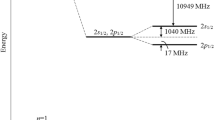Abstract
The main physical premises of the quantum Zeno effect in the problem of stopping the spontaneous radiative decay of excited atoms and nuclei are considered. It is shown for the first time that such an effect can be realized only for low-frequency radiative transitions (not higher than the microwave range), which correspond to the selective interaction of a quantum system with one or several discretely arranged modes of a quantized electromagnetic field in the volume of experimental setups. It is shown that this process occurs at the initial stage of the reversible Rabi precession and is formally unrelated to the true irreversible spontaneous decay. It is also shown that the effect of deceleration of radiative decay in the case of a quasi-continuous distribution of field modes is fundamentally impossible, which explains its absence for quantum sources of visible and shorter-wavelength radiation. In this case, the law of spontaneous radiative decay both at the beginning of the process and after a long time is described by the same standard exponential law. It has been shown for the first time that the quantum Zeno effect and stopping of spontaneous decay are possible in the infrared and visible ranges, provided that there are controlled sources inside the optical microresonators. These results can be used to create high-performance microlasers and to create optical systems for storing and processing information.
Graphical abstract



Similar content being viewed by others
Data Availability Statement
This manuscript has associated data in a data repository. [Authors' comment: Data sharing is not applicable to this article as no datasets were generated or analyzed during the current study. This article is purely theoretical and it has no additional data in a data repository. All the data that is used in the article is given in the article itself and there is no additional data.]
References
B. Misra, E.C.G. Sudarshan, The Zeno’s paradox in quantum theory. J. Math. Phys. 18, 756 (1977). https://doi.org/10.1063/1.523304
L.A. Khalfin, Contribution to the decay theory of a quasi-stationary state. Soviet Phys. JETP 6, 1053 (1958)
W.M. Itano, D.J. Heinsen, J.J. Bokkinger, D.J. Wineland, Quantum Zeno effect. Phys Rev A. 41, 2295 (1990). https://doi.org/10.1103/PhysRevA.41.2295
E.W. Streed, J. Mun, M. Boyd, G.K. Campbell, P. Medley, W. Ketterle, D.R. Pritchard, Continuous and pulsed quantum Zeno effect. Phys. Rev. Lett. 97, 260402 (2006). https://doi.org/10.1103/PhysRevLett.97.260402
M.C. Fischer, B. Gutiérrez-Medina, M.G. Raizen, Observation of the quantum Zeno and anti-Zeno effects in an unstable system. Phys. Rev. Lett. 87, 040402 (2001). https://doi.org/10.1103/PhysRevLett.87.040402
S. Becker, N. Datta, R. Salzmann, Quantum Zeno effect in open quantum systems. Ann. Henri Poincaré 22, 3795 (2021). https://doi.org/10.1007/s00023-021-01075-8
P. Facchi, S. Pascazio, Quantum Zeno dynamics: mathematical and physical aspects. J. Phys. A: Math. Theor. 41, 493001 (2008). https://doi.org/10.1088/1751-8113/41/49/493001
P.-W. Chen, D.-B. Tsai, P. Bennett, Quantum Zeno and anti-Zeno effect of a nanomechanical resonator measured by a point contact. Phys. Rev. B 81, 115307 (2010). https://doi.org/10.1103/PhysRevB.81.115307
J.M. Raimond et al., Quantum Zeno dynamics of a field in a cavity. Phys. Rev. A 86, 032120 (2012). https://doi.org/10.1103/PhysRevA.86.032120
F. Schäfer, I. Herrera, S. Cherukattil, S. Lovecchio, F.S. Cataliotti, F. Caruso, A. Smerzi, Experimental realization of quantum Zeno dynamics. Nat. Commun. 5, 3194 (2014). https://doi.org/10.1038/ncomms4194
A. Chaudhry, A general framework for the Quantum Zeno and anti-Zeno effects. Sci. Rep. 6, 29497 (2016). https://doi.org/10.1038/srep29497
V.I. Vysotskii, The problem of controlled spontaneous nuclear gamma-decay: theory of controlled excited and radioactive nuclei gamma-decay. Phys. Rev. C 58, 337 (1998). https://doi.org/10.1103/PhysRevC.58.337
V.I. Vysotskii, V.P. Bugrov, A.A. Kornilova, R.N. Kuzmin, The problem of gamma-laser and controlling of Mössbauer nuclei decay (theory and practice). Hyperfine Interact. 107, 277 (1997). https://doi.org/10.1023/A:1012063907842
V.I. Vysotskii, A.A. Kornilova, A.A. Sorokin, V.A. Komisarova, G.K. Riasnii, The theory and direct observation of controlled (suppressed) spontaneous nuclear gamma-decay. Probl. Atomic Sci. Technol. 6, 192 (2001)
A.A. Kornilova, V.I. Vysotskii, N.N. Sysoev et al., Generation of intense x-rays during ejection of a fast water jet from a metal channel to atmosphere. J. Surf. Invest. 4, 1008–1017 (2010). https://doi.org/10.1134/S1027451010060224
K. Vahala, Optical microcavities. Nature 424, 839–846 (2003). https://doi.org/10.1038/nature01939
J. Heebner, R. Grover, T.A. Ibrahim, Optical Microresonators: Theory, Fabrication and Application, 8th edn. (Springer-Verlag, Cham, 2008)
A.B. Matsko, Practical Applications of Microresonators in Optics and Photonics (CRC Press, Boca Raton, 2009)
R.K. Chang, A.J. Campillo, Optical Processes in Microcavities. Advanced Series in Applied Physics, vol. 3 (World scientific, Singapore, 1996)
I.H. Agha, Y. Okawachi, A.L. Gaeta, Theoretical and experimental investigation of broadband cascaded four-wave mixing in high-Q microspheres. Opt. Express. 17, 16209–16215 (2009). https://doi.org/10.1364/OE.17.016209
E. Schrödinger, Heisenbergschen Unschärfeprinzip. Ber. Kgl. Akad. Wiss. 24, 296 (1930)
H.P. Robertson, A general formulation of the uncertainty principle and its classical interpretation. Phys. Rev. 35, 667 (1930)
V.V. Dodonov, E.V. Kurmyshev, V.I. Man’ko, Generalized uncertainty relation and correlated coherent states. Phys. Lett. A 79, 150 (1980). https://doi.org/10.1016/0375-9601(80)90231-5
V.V. Dodonov, A.B. Klimov, V.I. Man’ko, Low energy wave packet tunneling from a parabolic potential well through a high potential barrier. Phys. Lett. A 220, 41 (1996). https://doi.org/10.1016/0375-9601(96)00482-3
V.I. Vysotskii, S.V. Adamenko, Correlated states of interacting particles and problems of the Coulomb barrier transparency at low energies in nonstationary systems. Tech. Phys. 55, 613 (2010). https://doi.org/10.1134/S106378421005004X
V.I. Vysotskii, M.V. Vysotskyy, S.V. Adamenko, Formation and application of correlated states in non-stationary systems at low energy of interacting particles. J. Exp. Theor. Phys. 114, 243 (2012). https://doi.org/10.1134/S1063776112010189
V.I. Vysotskii, M.V. Vysotskyy, Coherent correlated states and low-energy nuclear reactions in non stationary systems. Eur. Phys. J. A 49, 99 (2013). https://doi.org/10.1140/epja/i2013-13099-2
Author information
Authors and Affiliations
Contributions
All authors contributed equally to the paper.
Corresponding author
Rights and permissions
Springer Nature or its licensor holds exclusive rights to this article under a publishing agreement with the author(s) or other rightsholder(s); author self-archiving of the accepted manuscript version of this article is solely governed by the terms of such publishing agreement and applicable law.
About this article
Cite this article
Vysotskii, V.I., Vysotskyy, M.V. Fundamental prerequisites for realization of the quantum Zeno effect in the microwave and optical ranges. Eur. Phys. J. D 76, 158 (2022). https://doi.org/10.1140/epjd/s10053-022-00479-3
Received:
Accepted:
Published:
DOI: https://doi.org/10.1140/epjd/s10053-022-00479-3




